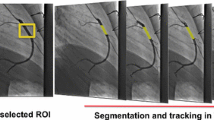Abstract
In clinics an accurate vessel segmentation method is important to quantize the vessel volume change with respect to time for artery elasticity measurement. This study proposes a modified version on 3D–expanded dynamic programming to find an optimal surface in a 3D matrix. The aim of this study is to discover the robustness against noises in measuring the cross-sectional area of the femoral artery on MRI datasets of ultra-endurance runners as accurately as possible. To do this, we use phantom images with different added noises and different image contrasts to find out the optimal parameters using grid search. The contrast between the vessel lumen and its background in phantom study is changed to simulate the real MRI dataset. We also add a plaque in phantom images to test the accuracy of the proposed algorithm in dealing pathologic cases. The phantom studies and grid search on selecting optimal parameters can offer an alternative way on parameter selection. In application to MRI, the accuracy is performed via comparisons between the manual tracings of experts and automated results. The mean relative error is 2.1 % ± 2.1 % on testing 11 MRI datasets (total 550 images). The phantom studies and grid search on selecting optimal parameters can offer an alternative way on parameter selection.












Similar content being viewed by others
References
Ziou, D., and Tabbone, S., Edge detection techniques: An overview. Int J Pattern Recognit Image Anal. 8(4):537–559, 1998.
Kirbas, C., and Quek, F., A review of vessel extraction techniques and algorithms. ACM Comput. Surv. 36(2):81–121, 2004.
Cai, K., et al., A Semi-Automatic Coronary Artery Segmentation Framework Using Mechanical Simulation. J. Med. Syst. 39(10):129, 2015.
Araki, T., et al., Reliable and accurate calcium volume measurement in coronary artery using intravascular ultrasound videos. J. Med. Syst. 40, 2016.
Rahebi, J., and Hardalaç, F., Retinal blood vessel segmentation with neural network by using gray-level Co-occurrence matrix-based features. J. Med. Syst. 38, 2014.
Kirbas, C. and F. Quek. Vessel extraction techniques and algorithms: a survey. In Third IEEE Symposium on Bioinformatics and Bioengineering 2003.
Liang, Q., et al., A multiscale dynamic programming procedure for boundary detection in ultrasonic artery images. IEEE trans. On. Med Imaging. 19:127–142, 2000.
Cheng, D.C., and Jiang, X., Detections of Arterial Wall in Sonographic Artery Images Using Dual Dynamic Programming. IEEE trans. On information technology in. Biomedicine. 12(6):792–799, 2008.
Cheng, D.C., et al., Automated detection of the arterial inner walls of the common carotid artery based on dynamic B-mode signals. Sensors. 10(12):10601–10619, 2010.
Cheng, D.C., et al., Using snakes to detect the intimal and adventitial layers of the common carotid artery wall in sonographic images. Comput. Methods Prog. Biomed. 67:27–37, 2002.
Cheng, D.-C., and Lin, J.-T., Three-dimensional expansion of a dynamic programming method for boundary detection and its application to sequential magnetic resonance imaging (MRI. Sensors. 12(5):5195–5211, 2012.
Sonka, M., et al., Segmentation of Intravascular Ultrasound Images: A Knowledge-Based Approach. IEEE trans On Med Imaging. 14:719–732, 1995.
Geman, D., et al., Boundary detection by constrained optimization. IEEE Trans. Pattern Anal. Mach. Intell. 12(7):609–628, 1990.
Cheng, D.C., et al., Automatic detection of the carotid artery boundary on cross-sectional MR image sequence using a circle model guided dynamic programming. Biomed. Eng. Online. 10(26):1–16, 2011.
Cheng, D., et al., Elliptic Shape Prior Dynamic Programming for Accurate Vessel Segmentation in MRI Sequences with Automated Optimal Parameter Selection. Journal of medical and. Biol. Eng., 2016 .In Press
Schütz, U.H., et al., The Transeurope footrace project: longitudinal data acquisition in a cluster randomized mobile MRI observational cohort study on 44 endurance runners at a 64-stage 4,486 km transcontinental ultramarathon. BMC Medicine. 10(78):1–33, 2012.
Huang, T., et al., Automated localization and boundary identification of superficial femoral artery on MR image sequences. Computer Methods in Biomechanics and Biomedical Engineering. 16(8):873–884, 2013.
Gudbjartsson, H., and Patz, S., The Rician distribution of noisy MRI data. Magn. Reson. Med. 34(6):910–914, 1995.
M., B.J., and G., A.D., Statistical methods for assessing agreement between two methods of clinical measurement. Lancet. 1:307–310, 1986.
Caselles, V., Kimmel, R., and Sapiro, G., Geodesic active contours. Int. J. Comput. Vis. 22(1):61–79, 1997.
Acknowledgments
This work was supported by the National Science Council with the grant number MOST 104-2221-E-039-002, Taiwan. The authors acknowledge Dr. Uwe Schütz (University Hospital of Ulm, Germany) for providing real MRI sequences and their manual tracings to be the gold standard.
Author Contributions
Cheng DC designed the algorithm and the experiments, writing of the paper; Wu JF wrote the program code; Liu SH and CH Su examined the experiments; and Gao YH made the statistics and gave suggestions in manuscript writing.
Author information
Authors and Affiliations
Corresponding author
Ethics declarations
Conflicts of Interest
The authors declare no conflict of interest.
Additional information
This article is part of the Topical Collection on Systems-Level Quality Improvement
Rights and permissions
About this article
Cite this article
Cheng, DC., Wu, JF., Kao, YH. et al. Accurate Measurement of Cross-Sectional Area of Femoral Artery on MRI Sequences of Transcontinental Ultramarathon Runners Using Optimal Parameters Selection. J Med Syst 40, 260 (2016). https://doi.org/10.1007/s10916-016-0626-y
Received:
Accepted:
Published:
DOI: https://doi.org/10.1007/s10916-016-0626-y




